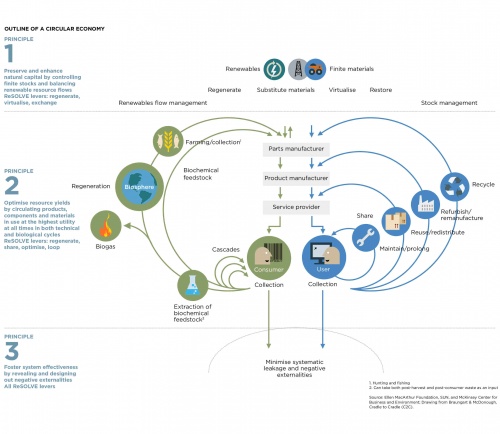Category:Guiding philosophies.CircularEconomy
Principles of a Circular Economy 1. Preserve and enhance natural capital by controlling finite stocks and balancing renewable resource flows ReSOLVE levers:
a. regenerate,
b. virtualize,
c. exchange
2. Optimise resource yields by circulating products, components and materials in use at the highest utility at all times in both technical and biological cycles. ReSOLVE levers:
a. Regenerate
b. Share
c. Optimize
d. Loop
3. Foster system effectiveness by revealing and designing out negative externalities. All ReSOLVE levers.
RENEWABLES
A consumer contributes and recyclables are collected. Others may use items collected through Thrift Stores, Habitat for Humanity ReStore, Freight Salvage, CraigsList, and similar enterprises. The process should minimize systematic leakage, damage, waste, contamination, and other negative externalities.
From items unable to be reused for their initial application, component parts, metals, and biochemical feedstock may be extracted.
Remaining “trash” may be used (burned) to create biogas.
Regeneration is the process of using biochemical feedstock in farming which regenerates food for humans, animals and fish.
Renewable materials may optimally be substituted for finite materials.
FINITE MATERIALS
Three major groups contribute to the creation of products:
1. Parts manufacturers
2. Product manufacturers
3. Service providers
Parts manufacturers benefit in some cases by recycling finite materials.
Part and Product manufacturers sometimes refurbish or re-manufacture to reduce scrap. Products can often be reused or redistributed.
Service providers maintain products to prolong their useful service.
Users are able to employ items for their intended use, share with others to extend the benefit, and to collect and contribute obsolete or broken items to be recycled.
This category currently contains no pages or media.
